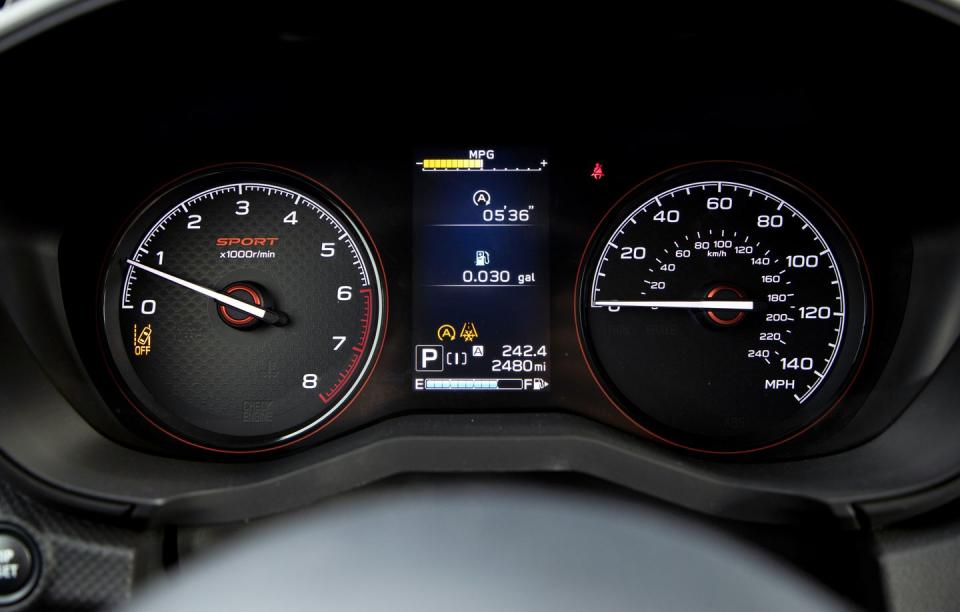Subaru Forester's New Gauge Tracks Engine-Off Fuel Savings

The recent inundation of the market of vehicles with the ability to switch off their engines while at a stop and then quickly refire when needed happened for one reason: automakers' desire to boost fuel-economy ratings. But the sometimes shuddery way in which the engines perform this routine has also annoyed plenty of drivers unaccustomed to and unfamiliar with this often overly tactile and auditory stoplight switcheroo. Which is why all but the most foolhardy automakers include a switch to disable this feature-although, annoyingly, it has to be redone every time the vehicle is started. (That's so the automaker can reap the maximum fuel-economy rating.)
But what about convincing the driver of the benefits of this functionality? That's the route Subaru appears to be taking with a new display it has added to the equally new Forester's trip computer in the gauge cluster. It tallies the total engine-off time in minutes and seconds as well as the gallons saved-down to the thousandth-during that time. Subaru says this allows its customers "to get a sense of their individual contribution to environmental preservation along with lower fuel costs." It may also serve as a distraction from the less-than-smooth nature in which Subaru's flat-four goes to sleep and then wakes again during its newly acquired stop/start routine.
An average car consumes a gallon of fuel roughly every three hours it spends idling, which suggests that saving a thousandth of a gallon of fuel requires about 11 seconds of engine-off time. Not surprisingly, then, the Forester's saved-gallons count rises agonizingly slowly. But I have to admit, Subaru's approach was working when I drove the car recently, in that I was often silently trying to will the Forester away from a mid-stoplight restart that would slow my tally.
Over the course of 24 hours, making my 30-mile daily commute plus a number of errands, my total distance traveled was 120 miles. That's nearly three times more than the average day for someone who clocks 15,000 miles a year. And, in those miles, which were largely stop-and-go city driving and well suited to driving up engine-off time, I managed a grand total of 10 minutes and three seconds with the engine off, and, according to the Forester's readout, 0.085 gallons saved.

Here's where it gets complicated: The displayed figure equates to a consumption rate of 0.5 gallons per hour at idle, which is nearly 70 percent higher than today's norms. So one of three things must be true: Subaru's engine is inefficient, its readout is, or it's padding the numbers it's displaying, perhaps grounded in worst-case assumptions (such as maximized accessory loads). We reached out to Subaru for an explanation, but the company hasn't provided a response at this writing.
Other automakers have estimated overall fuel-economy savings between 3 and 10 percent for their stop/start systems, but such calculations are strongly dependent on the duty cycle-lots of idling time equals more savings. Regulatory fuel economy test cycles in the U.S., Japan, and Europe vary on this score, with Japan's incorporating the greatest portion of time idling. Subaru's readout is the first time we've encountered an attempt to measure real-world savings and report them to the car owner in real time, however.
Using the number from the readout, and with the nationwide average price of regular that day at $2.69 a gallon, I saved 23 cents. Projecting out, that's just under $100 every 50,000 miles, representing a savings of 2 percent of the $4600 that would be spent on fuel over those miles for a Forester equaling its 29-mpg EPA combined estimate. (Using the expected consumption at idle would instead yield savings of 0.05 gallons, 14 cents, and $56 every 50,000 miles.)
Is somewhere between $50 and $100 every three or so years enough to keep your finger away from the stop/start off switch?
('You Might Also Like',)

